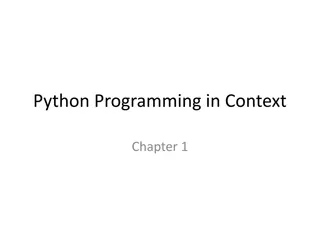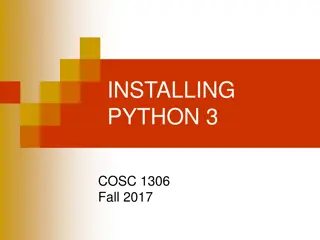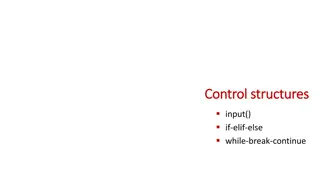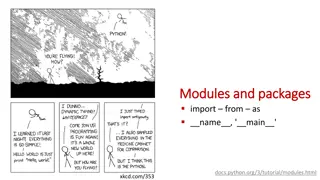
Understanding Python's Input Function and Usage
Learn how to utilize Python's built-in input function to receive user input in your programs. Explore the function's behavior, argument requirements, and how to handle user input for various data types like strings, integers, and floats.
Download Presentation

Please find below an Image/Link to download the presentation.
The content on the website is provided AS IS for your information and personal use only. It may not be sold, licensed, or shared on other websites without obtaining consent from the author. If you encounter any issues during the download, it is possible that the publisher has removed the file from their server.
You are allowed to download the files provided on this website for personal or commercial use, subject to the condition that they are used lawfully. All files are the property of their respective owners.
The content on the website is provided AS IS for your information and personal use only. It may not be sold, licensed, or shared on other websites without obtaining consent from the author.
E N D
Presentation Transcript
Getting Input in Python Assumes assignment statement, typecasts
Input in Python Most programs need some input from the outside world, i.e. the user The most common input device is the keyboard To get the user s input into the program, you use the input function built into Python
What to ask about any builtin function? How many arguments does it have? What type are the arguments? What does the function do? (the semantics) What type does the function return? (if it returns anything!)
The input function The input function has one argument, which must be a string. This string is displayed as a prompt to the user. The argument can also be empty, that is, nothing between the parentheses. Then nothing is displayed as a prompt. The input function pauses the running of the program, displays the prompt if there is one, shows a blinking cursor, and waits for the user to press the Enter key. When the Enter key is pressed, whatever the user typed at the keyboard is returned as the result of the function. The user can press just the Enter key, in which case the empty string is returned.
Using the input function Since the function returns a value (a string), it must be called as part of a statement Typical calls Answer = input( What s your name? ) size = int(input( How many points? )) temperature = float(input( What s the current temperature? )) Don t forget the variable name and assignment operator to the left! Note the typecasts they are necessary if you are going to use the user s input as a number






















